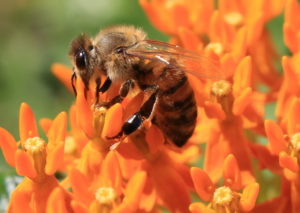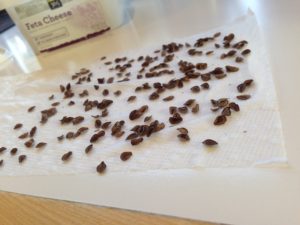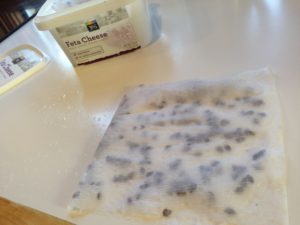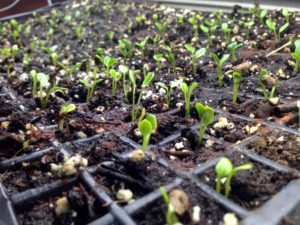
Honey bee on Butterflyweed (Asclepias tuberosa)
Butterflyweed, or Asclepias tuberosa, is great for pollinators and a required host for Monarch butterflies, whose caterpillars eat the toxic plant as a way to protect themselves from predators.
Many other pollinators, including native solitary bees, flock to the showy orange flowers as well.
They can be grown from seed very, very, easily. Or, if you prefer, you can grow them only moderately easily if you want to watch it grow indoors or plant in a very specific location.

Harvesting Butterflyweed seeds from the pods.
If you’re reading this in the fall or the middle of a snowless winter, you can still do the “easy method.” If you’re hunkered down indoors or if you’ve got a special interest in growing the plants indoors for transplanting, you’ll have to take the less-easy, but more interesting, “watch it grow” method.
For the past few years I’ve been helping at my son’s school where kids have saved and distributed thousands of Butterfly weed seeds as well as sown, grown and distributed hundreds of seedlings as part of a program to learn more about seeds, plants, pollinators and especially the Monarch Butterflies.
Please keep in mind that the plants usually don’t produce their showy flowers until their second year. Their first year they’ll grow 6”-12” tall, with no flowers. Their second year is when they begin to show off.
UPDATE: See a short video on how to harvest seeds without the silks.
Easy method: Between Fall and February, choose a full-sun to half-sun location in your yard. Gently scratch the surface of the soil. Spread Asclepias tuberosa seeds in that location, giving 6”-24” of space between, and lightly cover them with soil. Water gently (weather dependent). Return in late-April to early-May to see that they’re growing. Rejoice.

Spread seeds on half of paper towel.
Watch and grow method: If you prefer a more of a hands-on experience then mid-January to mid-February, start “cold stratification,” giving seeds the environmental cues that tell them it is time to begin germination.
1. Dampen a paper towel, place seeds on half the towel and fold.
2. Place the towel in a container (old bread bag, cleaned whipped cream container, ziplock bag, etc.) and let it sit in the refrigerator for 4-8 weeks. (I typically aim for 4-6 weeks, maximum.) Set the sowing date in your calendar so you don’t forget!

Fold to cover seeds.
Feel free to peek, as long as the seeds get returned to the cold, moist environment in the refrigerator.
3. At the appropriate date, plant the seeds in a trays, paper pots or whatever you plan to use, with good potting mix or compost. Set the seeds on top and then sprinkle a light covering of more soil so the seed is barely covered.
Or if past the last frost date, you can plant straight outside. (This isn’t the preferred or recommended method, but I’ve had surprisingly good success with it.) If you plan on sowing outdoors after the last frost, start stratification mid-March and spread outdoors mid-April.

Seedlings about two weeks after sowing.
If you leave the seeds in paper towel too long, they’ll begin to mold and rot, so set it in your calendar to sow them about 4-8 weeks after they’re put in the fridge!
Location considerations: Butterfly weed requires very little water after they’re established, but like any seedling, give them some love their first year.
They prefer full sun – but will still grow decently in half sun. In full sun, plants will mature into 2’-3’ tall plants with batches of small orange flowers from mid-summer to fall that pollinators, including the monarch and other butterflies love. In less sun they seem to be smaller with smaller, but still plentiful blooms.
Importantly – please do not to use pesticides
if you’re attracting pollinators to your yard!
Also please note that while native Americans and early settlers frequently used the plant for medicinal purposes, it may be toxic if not prepared properly.
Thank you for helping the Monarchs!
EDIT: If you’re looking to track the monarchs, this is a great site with maps.
